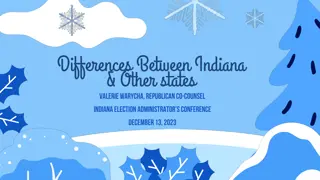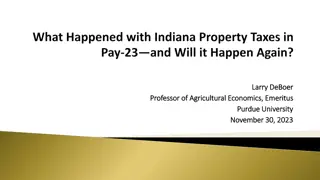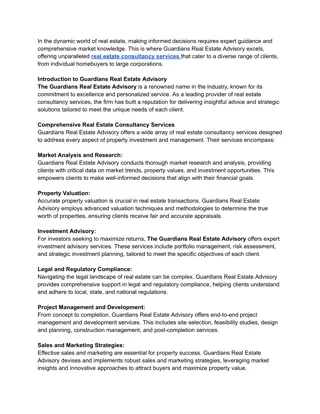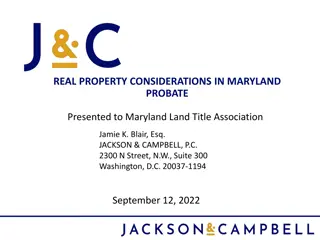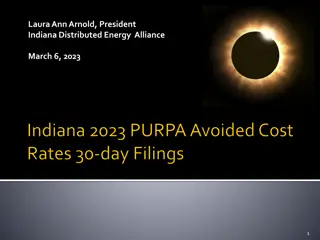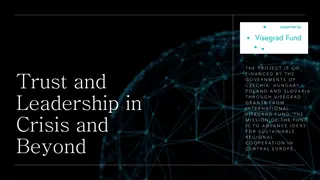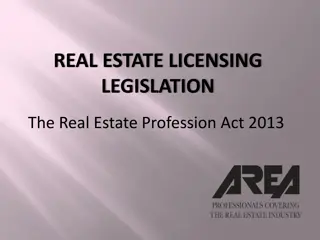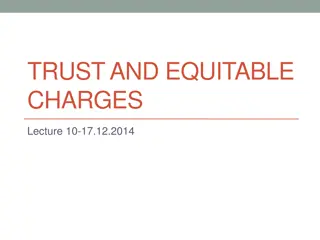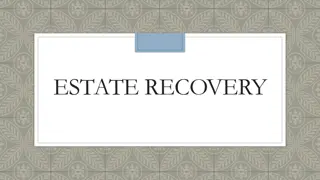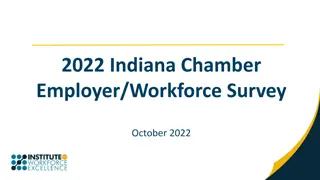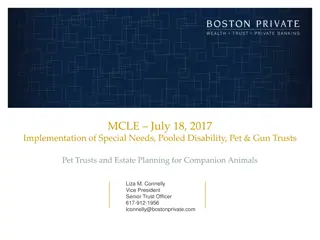Overview of 2022 Indiana Estate & Trust Legislation
Detailed presentation of 2022 Indiana estate and trust legislation enacted during the 2022 Session, including changes in statutes effective July 1, 2022, and beyond. Covering topics such as technical corrections, updates, distributions from supervised estates, small estate affidavits, and the enactment of the Uniform Trust Decanting Act in Indiana.
Download Presentation

Please find below an Image/Link to download the presentation.
The content on the website is provided AS IS for your information and personal use only. It may not be sold, licensed, or shared on other websites without obtaining consent from the author. Download presentation by click this link. If you encounter any issues during the download, it is possible that the publisher has removed the file from their server.
E N D
Presentation Transcript
2022 Indiana Estate & Trust Legislation (enacted during the 2022 Session) Jeffrey S. Dible April 21, 2022 Estate Planning Council of Indianapolis 1
Disclaimer All of the 2022 Enrolled Acts covered in this presentation have been signed by Governor Holcomb. The primary materials for this program are contained in Jeff Dible s companion paper. Opinions expressed in this presentation are those of Jeff Dible and should not be attributed to Frost Brown Todd LLC or to the Indiana State Bar Association. 2
A Preview of Whats In the Companion Paper o Summary of HEA 1208 (estate & trust technical corrections and updates to slayer rule ) o Summary of and text from SEA 66 (distributions from closed supervised estates) o Summary of and text from SEA 67 (increase in ceiling to $100,000 for small estate affidavits ) o Summary of SEA 357 (county auditor and assessor processing of documents submitted in electronic form ) o Summary of HEA 1205 (Indiana s enactment of Uniform Trust Decanting Act) o Some details on the new rules and procedures under the Uniform Trust Decanting Act 3
Effective Date o All the new statutes covered in this presentation have an effective date of July 1, 2022 o So, the changes apply to decedents dying or to proceedings filed or pending on or after July 1, 2022 o Some changes in Senate Enrolled Act 357 won t be effective and enforceable until January 1, 2024 4
House Enrolled Act 1208 (P.L. 162-2021) o With respect to notice in estate and guardianship proceedings, conforms the text of many Probate Code and guardianship sections to actual current practice in the E-filing era under Trial Rules 86 and 87 by requiring the personal rep or guardian or his or her lawyer (instead of the Clerk) to mail all required notices o Fixes contradictions in the summary closing of small unsupervised estates statutes ( 29-1-8-3 and -4) Distribute net assets first, then file closing statement o Fixes a contradiction in I.C. 29-1-16-6 and -7 for final accountings in supervised estates Issue notice of hearing to beneficiaries > 30 days before hearing date AND state that beneficiaries must file objections > 14 days before hearing 5
House Enrolled Act 1208 (continued) o Rewrites the appointment of special administrator statute (I.C. ( 29-1-10-15) to add notice and hearing requirements and to comply with the Supreme Court s decision in Estate of Lewis, 123 N.E.3d 670 (2019) o Adds a new 29-1-10-15.5 which will govern the procedure for appointing a special administrator solely for the purpose of bringing a wrongful death action o Revises I.C. 30-4-6-4 and 30-4-6-7 to eliminate the technical concept of docketing for trusts (just file a copy of the trust instrument with the probate court along with a pleading explaining why the court needs to be able to see and review the trust instrument) 6
House Enrolled Act 1208 (slayer rule update) o Revises, expands and clarifies the slayer rule in I.C. 29-1-2-12.1, which was intended to prevent a murderer from profiting from the crime by inheriting assets from the deceased victim The old version of this statute was last amended in 2005 and refers to assets that pass through an estate or by a trust to the perpetrator or killer, but does NOT specifically refer to life insurance or other non-probate assets The old version of the statute did not explicitly apply to a murder followed by killer s suicide situation ISBA proposed a revised section 12.1 in 2021 7
House Enrolled Act 1208 (slayer rule update) o The rewritten 29-1-2-12.1 is similar to the ISBA s proposed rewrite but is shorter, and was passed by the Senate as Senate Bill 132 The main innovations in revised section 12.1 are definitions of unlawful death, decedent [the victim], and culpable person Unlawful death means death resulting from murder, voluntary manslaughter, or causing suicide (not assisting suicide) Culpable person means a person who caused the unlawful death, as established by (a) guilty plea or conviction in a criminal case or (b) a civil action establishing knowing and intentional killing by a preponderance of the evidence 8
House Enrolled Act 1208 (slayer rule update) o The defined term culpable person also includes the estate of a person who knowingly and intentionally causes the unlawful death and who later dies (makes the slayer rule apply in a murder-suicide situation o The definitions of culpable person and unlawful death will prevent the slayer rule from applying to a person who commits negligent or reckless homicide that results in the death of a family member o New subsection 12.1(c) contains a non-exhaustive list of property interests which the culpable person inherits and to which the slayer rule applies, including trust assets, TOD assets, the decedent s (victim s) interest in joint tenancy assets, and property passing under a contractual agreement upon death 9
House Enrolled Act 1208 (slayer rule update) o Under revised 29-1-2-12.1. the slayer rule still imposes a constructive trust (equitable remedy) upon the property that the culpable person inherits or receives as a result of the unlawful death of the decedent The slayer rule does not cause a forfeiture of the culpable person s inherited property interest The culpable person holds the inherited property as constructive trustee for the innocent persons (other trust or estate beneficiaries, other designated beneficiaries, etc.) who would be legally entitled to receive the property if the culpable person had died immediately before the decedent or victim (subsection (f)) 10
House Enrolled Act 1208 (slayer rule update) o The slayer rule applies upon the culpable person s receipt of the property and imposes a constructive trust on the property in the culpable person s hands o The constructive trust remedy means that the innocent next of kin or other beneficiaries of the deceased victim may need to engage in further litigation against the culpable person to enforce the constructive trust o Under I.C. 29-1-2-12.1 as amended, the slayer rule does not change the status of the culpable person as an estate or trust beneficiary, designated beneficiary, or surviving joint tenant who is entitled on paper to inherit the asset 11
House Enrolled Act 1208 (slayer rule update) o Subdivision (c)(6) [ property passing under a contractual agreement upon the decedent s [victim s death ] could apply to proceeds from an IRA, pension or other retirement account But the slayer rule can t prevent the custodian or plan administrator from paying the proceeds to the culpable person as a designated beneficiary o A special rule in subsection 12.1(d) applies to life insurance proceeds and codifies existing case law If the life policy insured the victim OR if the life policy insured the killer (murder followed by suicide), the insurance company can pay out the proceeds as if the killer predeceased the victim 12
House Enrolled Act 1208 (continued) o Makes narrow technical (wording) corrections to the health care Advance Directive statute (SEA 204 of 2021) and the electronic will and POA statutes In the definition of present / presence (I.C. 16-36-7-19), replaces one erroneous instance of testator with declarant (for advance directives) In I.C. 29-1-21-16, update a cross-reference to refer to Rules on Access to Court Records In 29-1-22-1, update definition of electronic POA to refer to use of 2 attesting witnesses instead of notarization In 30-5-4-1.9, replace probate of a POA with validity and enforceability of a POA 13
Senate Enrolled Act 66 (P.L. 150-2022) o The bill and the subject were proposed by Sen. Mike Young and appeared to be a solution in search of a problem o The problem: A solvent, supervised estate is closed but for some reason, a known asset(s) identified in the inventory and final accounting remain undistributed after the personal representative is discharged This should not happen frequently, because the P R gets discharged under I.C. 29-1-17-13 only after the P R has (a) received a decree of final distribution under I.C. 29-1-17-2 AND (b) filed a supplemental report of distribution with receipts showing that distributions were made as ordered 14
Senate Enrolled Act 66 (continued) o The solution: New section 29-1-17-13.5 applies only to closed supervised estates and creates a 90-day period after the entry of the order of discharge under 29-1-17-13 If an asset identified in the inventory or the final accounting remains undistributed, the P R (despite the discharge) can act during the 90-day period to make the distribution (subsection (e)(1)) If the discharged P R is not available to act or refuses to act, a beneficiary entitled to the distribution can petition the court within the 90-day period for an order compelling the P R to make the distribution (subsection (e)(2)) 15
Senate Enrolled Act 66 (continued) o If the decree of final distribution (under 29-1-17-2) identifies the undistributed asset and its recipient(s) specifically enough: Subsections (b) and (c) of new 29-1-17-13.5 allow a distributee who is entitled to the asset to file an affidavit with the court (for personal property) or to record an affidavit with the recorder (for real property) For real property that remained undistributed, recording the affidavit and a copy of the distribution decree is mandatory (subsection (d)) This works because the distribution decree itself is a title transaction document ( 32-20-2-7(4)) 16
Senate Enrolled Act 66 (continued) o If the undistributed asset is an interest in real property, the P R can simply record a deed (naming the correct distributee as the grantee) within the 90-day period (subsections (b)(2) and (e)(1) of 29-1-17-13.5) o The P R who acts within 90 days after discharge does not need to obtain any court order before making the distribution o New section 13.5 does not require the P R to file any follow-up report or affidavit with the court, but it is a good idea to do so o If a previously undiscovered or overlooked estate asset was not covered in the final accounting and distribution decree, use I.C. 29-1-17-14 17
Senate Enrolled Act 67 (P.L. 151-2022) o Increases the small estate affidavit ceiling amount under I.C. 29-1-8-1 to $100,000 for decedents dying after June 30, 2022 o Also increases the related ceiling amount under 29- 1-8-3 to $100,000, with the same effective date o In the last Probate Code Study Commission proceedings in 2021, the ISBA s PTRP Section pushed for an increase from $50,000 to $100,000 The last previous increase in the ceiling was from $25,000 to $50,000, effective July 1, 2006 Increases in real property market values over the past 16 years made an increase to $100,000 justifiable 18
Senate Enrolled Act 67 (continued) o The introduced Senate Bill 67 would have increased the ceiling to $100,000 o Was passed by the Senate 43 to 4 o Most of the legislators who opposed the Bill are small firm or solo lawyers who are concerned about losing small estate administration business OR about an unscrupulous distributee using a small estate affidavit to empty out a $99,000 bank account and skip town with the money o SB 67 s passage in the Senate and a 9-to-1 do pass vote in the House Judiciary Committee showed that there was widespread support for increasing the ceiling from $50,000 to $100,000 19
Senate Enrolled Act 67 (continued) o Rep. John Young (House sponsor) recalled discussion in the Probate Code Study Commission (Fall 2021) in which both $75,000 and $100,000 were discussed as increased ceiling amounts o In mid-February 2022, Rep. Young said he would file a floor amendment in the House to change the increased ceiling amount to $75,000 o However, Rep. Young caused or allowed himself to be removed as the House sponsor of Senate Bill 67, and it passed in the House 83 to 1 (with Rep. Young voting NO), increasing the ceiling amount to $100,000 as approved in the Senate 20
Senate Enrolled Act 67 (continued) o Some caveats to keep in mind when considering the use of small estate affidavits instead of supervised or unsupervised administration: I.C. 29-1-8-1 has long required and still requires the affiant to list ALL distributees who have an interest in the asset to be collected I.C. 29-1-8-1 has long required and still requires the affiant to notify all the other distributees that the affidavit is being used to collect the asset The affiant has an obligation to properly divide collected assets with the other distributees Use of the affidavit doesn t eliminate actual or potential creditor claims (9-month bar date) 21
Senate Enrolled Act 357 (P.L. 50-2022) o Pertains to the processing of recordable real estate documents that are submitted to county officials in native electronic format instead of on paper County auditors ( endorsement function) and county assessors (sales disclosure forms) have the practical power to block the recording of submitted electronic documents The auditors and assessors did not consent to positive changes in 2021 House Enrolled Act 1255 SEA 357 provides that county auditors and assessors cannot refuse to process electronic documents after December 31, 2023 Electronic documents can be converted to paper form for recording ( 32-21-2.5-8) 22
House Enrolled Act 1205 (P.L. 161-2022) o The first section of HEA 1205 makes a welcome insertion into the Indiana Trust Code to make it easier for 2 or more successor trustees to be appointed with division of powers and responsibilities New 30-4-3-29.3 will apply whenever a provision in a trust instrument OR 30-4-3-33 gives someone the power to fill a vacancy to appoint a successor trustee Such a power to appoint a successor trustee will include the power to appoint 2 or more trustees and to establish a division of labor, so that each trustee will have non-overlapping powers, duties and potential liabilities 23
House Enrolled Act 1205 (continued) o The rest of HEA 1205 repeals Indiana s existing trust decanting statute ( 30-4-3-36) and enacts Indiana s version of the Uniform Trust Decanting Act (UTDA), which has been enacted by 12 other states o Some problems with the old / existing trust decanting statute that are addressed by the Uniform Act: Existing section 36 bases the trustee s power to decant on the old conceptual model of a discretionary power to distribute principal in further trust for an existing beneficiary of the current trust Existing section 36 has allowed trustees to make foolish mistakes through ill-conceived decanting 24
House Enrolled Act 1205 (continued) o Continued list of problems with the existing trust decanting statute that the Uniform Act addresses: Existing 36 does not address practical and tax issues that could result from decanting where the first or existing trust includes both charitable and non-charitable beneficiaries and interests Existing 36 is silent on whether the terms of the second trust can create or grant a power of appointment that is exercisable in favor of persons who are not beneficiaries of the existing trust Existing 36 does not specifically prohibit a trustee from using decanting to increase trustee fees or to reduce the standard of liability 25
House Enrolled Act 1205 (continued) o Continued list of problems with the existing trust decanting statute that the Uniform Act addresses: Existing 36 does not address the potential loss of tax benefits EXCEPT to prohibit terms in the second trust that would jeopardize or lose a gift or estate tax charitable or marital deduction claimed for a transfer to the existing trust Existing 36 does not mention trust beneficiaries who are disabled, and if a disabled beneficiary of the existing trust is currently entitled to an outright distribution or to a mandatory income, annuity, or unitrust interest, decanting cannot be used to give that disabled beneficiary a discretionary interest in the second trust 26
House Enrolled Act 1205 (continued) o Indiana s version of the Uniform Act is new chapter 10 (I.C. 30-4-10) added to the Indiana Trust Code o Indiana s version of the Uniform Act makes no important changes to the national Act s text except for added references to trust directors (under our I.C. 30-4-9) and the addition of a detailed definition of beneficiary with a disability in new I.C. 30-4-10-6 o Indiana s new statute, like the national Act, includes important additional definitions [ noncontingent right, presumptive remainder beneficiary, vested interest, etc.] in new 30-4-10-41(a) thru (d) o An authorized fiduciary (new 30-4-10-4) is any trustee or trust director with the discretionary power to make or direct principal distributions 27
House Enrolled Act 1205 (continued) o The first main innovation in the national UTDA (and in Indiana s version) is the expanded definition of the decanting power : Includes the trustee s power to distribute property from the existing trust to 1 or more second trusts ALSO includes the trustee s power to modify the terms of the first (existing) trust without distributing any assets to an actual second trust [see new 30-4-10-12(2)] o The second innovation is the distinction between expanded distributive discretion (if the trustee has it under the terms of the first trust) and limited distributive discretion 28
House Enrolled Act 1205 (continued) o Under the current (pre-2022) decanting statute, 30- 4-3-36, the trustee s possession of any discretion to invade and distribute principal gives that trustee the full power to make any permitted change in the structure and terms of the second trust (such as eliminating any remainder beneficiary), even if the discretionary distribution power is limited by some ascertainable standard such as HEMS o But the new Indiana decanting statute limits the changes that the trustee can make through decanting if the trustee does not have expanded distributive discretion under the first (existing) trust s terms o The opportunity to use the old decanting statute runs out not later than June 30, 2022, at the latest 29
House Enrolled Act 1205 (continued) o The new statute (I.C. 30-4-10-14) defines expanded distributive discretion as a discretionary power of distribution that is not limited to an ascertainable standard or a reasonably definite standard o If the trustee has expanded distributive discretion, then the decanting power can be exercised to make any change in the second trust that is not prohibited in the rest of new I.C. 30-4-10 [see new I.C. 30-4-10- 33(a)] o A trustee with expanded distributive discretion must still exercise the decanting power in a manner consistent with the first trust s purposes [see new I.C. 30-4-10-33(b)] 30
House Enrolled Act 1205 (continued) o The new statute (I.C. 30-4-10-42(a)) defines limited distributive discretion as a discretionary power of distribution that is limited to an ascertainable standard or a reasonably definite standard o If the trustee has only limited distributive discretion, then the trustee can decant, but under subsection 42(c) A second trust must grant each beneficiary of the first trust beneficial interests that are substantially similar to the beneficial interests of the beneficiary in the first trust. o A trustee with only limited distributive discretion can still make a wide variety of administrative changes 31
House Enrolled Act 1205 (continued) o If the trustee of the existing or first trust has only limited distributive discretion, what kinds of changes can the trustee make to a beneficiary s interest under the second trust and still comply with the substantially similar requirement in I.C. 30-4-10- 42(c)? If the first trust entitles beneficiary B to direct mandatory distribution(s), the second trust can permit indirect distributions for the benefit of B Or if the trustee reasonably believes that B is incapacitated or under a disability, the trustee can make, in the terms of the second trust, any change in B s interest that is permitted under any part of the decanting statute (I.C. 30-4-10) 32
House Enrolled Act 1205 (continued) o What rules, principles and procedures for trust decanting under the pre-2022 Indiana statute are not changing under the new statute (I.C. 30-4-10)? The settlor of the first or existing trust can explicitly prohibit or restrict the use of decanting The settlor of the first or existing trust can include a special decanting power that would permit changes prohibited under the statute A trustee who has a decanting power cannot be forced to exercise it A trustee s exercise of a decanting power that complies with the statute could still be found to violate the first trust s purposes or to be a breach of a fiduciary duty owed by the trustee 33
House Enrolled Act 1205 (continued) o What rules, principles and procedures for trust decanting under the pre-2022 Indiana statute are not changing under the new statute (I.C. 30-4-10)? If a beneficiary is not disabled and has any of five defined types of vested interest under the terms of the first trust, the second trust cannot reduce or eliminate that vested interest [section 41(f)(3)] The terms of the second trust cannot add a current beneficiary who is not a current beneficiary of the first trust [section 41(f))(1)] The terms of the second trust cannot add a successor beneficiary who is not a current beneficiary, successor beneficiary, or presumptive remainder beneficiary of the first trust ( 41(f)(2)) 34
House Enrolled Act 1205 (continued) o What rules, principles and procedures for trust decanting under the pre-2022 Indiana statute are not changing under the new statute (I.C. 30-4-10)? A trustee can petition the probate court for instructions or guidance about whether or not to decant [new 30-4-10-39 is more detailed] Decanting does not require probate court approval With limited exceptions under I.C. 30-4-10-46 and -48, decanting does not require the consent of any beneficiary The trustee must send a pre-decanting notice 60 days in advance to all qualified beneficiaries of the first trust (and to the attorney general if there is a charitable interest) [see 30-4-10-35 and -36] 35
House Enrolled Act 1205 (continued) o What rules, principles and procedures for trust decanting under the pre-2022 Indiana statute are not changing under the new statute (I.C. 30-4-10)? The 60-day waiting period (after notice and before the trustee can proceed with decanting) can be waived, but only if all persons entitled to notice sign written waivers [ 30-4-10-35(d)] After the 60-day waiting period ends or has been validly waived, the trustee actually exercises the decanting power by signing a written record with specified content [ 30-4-10-40] The written record of decanting must identify the first and second trusts and the property that is being distributed to the second trust 36
House Enrolled Act 1205 (continued) o A non-exclusive list of new or clarifiedprovisions that are in the new decanting statute (I.C. 30-4-10) but not in the pre-2022 statute: I.C. 30-4-10-41(g) and (h) allow the terms of the second trust to create or modify appointment powers that are exercisable by current beneficiaries or presumptive remainder beneficiaries of the first trust, even if the appointment powers can be exercised in favor of persons who are not beneficiaries of the first trust I.C. 30-4-10-41(g) 30-4-10-42(c) allow decanting to change the governing law for the second trust unless doing so would impair a charitable interest 37
House Enrolled Act 1205 (continued) o A non-exclusive list of new or clarifiedprovisions that are in the new decanting statute (I.C. 30-4-10) but not in the pre-2022 statute (continued): If a beneficiary of the first trust fits the broad definition of beneficiary with a disability, then even if the disabled beneficiary has a vested interest (such as a right to receive an immediate lump-sum distribution or a mandatory life income interest), new I.C. 30-4-10-43 permits the trustee or a special needs fiduciary to decant to a second trust that functions as a discretionary special needs trust for that disabled beneficiary Subsection 43(f) specifically mentions first-party (d)(4)(A) trusts and (d)(4)(C) pooled trusts 38
House Enrolled Act 1205 (continued) o A non-exclusive list of new or clarifiedprovisions that are in the new decanting statute (I.C. 30-4-10) but not in the pre-2022 statute (continued): New 30-4-10-44 contains detailed rules which prohibit the use of decanting to diminish a charitable interest under the first trust or to alter a charitable purpose or a condition or restriction stated in the first trust If a charitable interest in the first trust is a determinable charitable interest (as defined), then the second trust cannot change the governing law unless (a) the attorney general consents in writing, (b) the A.G. fails to object in writing before the end of the notice period, or (c) the court approves 39
House Enrolled Act 1205 (continued) o A non-exclusive list of new or clarifiedprovisions that are in the new decanting statute (I.C. 30-4-10) but not in the pre-2022 statute (continued): If the first trust instrument specifies the compensation of a fiduciary who has authority to decant, new 30-4-10-46 prohibits the use of decanting to increase that fiduciary s compensation under the second trust s terms unless the probate court approves the increase or all qualified beneficiaries of the second trust consent in writing to the increase New 30-4-1-47(a) and (c) generally prohibit a reduction of fiduciary liability in the aggregate or reducing any authorized fiduciary s standard of liability under the second trust 40
House Enrolled Act 1205 (continued) o A non-exclusive list of new or clarifiedprovisions that are in the new decanting statute (I.C. 30-4-10) but not in the pre-2022 statute (continued): Under new 30-4-1-47(b), the terms of the second trust can provide for indemnification of an authorized fiduciary of the first trust for any liability or claim that would have been payable from the first trust if the decanting power had not been exercised Under new 30-4-1-47(d), the terms of the second trust can divide and allocate fiduciary powers and responsibilities among multiple trustees and/or trust directors [this was implied under the pre-2022 decanting statute but not explicitly stated] 41
House Enrolled Act 1205 (continued) o A non-exclusive list of new or clarifiedprovisions that are in the new decanting statute (I.C. 30-4-10) but not in the pre-2022 statute Under new 30-4-1-48(b), if the first trust instrument gives a person the power to remove an authorized fiduciary who could decant, the terms of the second trust cannot modify that removal power unless the probate court approves or unless the power holder and/or qualified beneficiaries consent in writing New 30-4-1-49 contains long, detailed provisions intended to prevent the inadvertent loss or impairment of tax benefits or the creation of certain tax problems as a result of decanting 42
House Enrolled Act 1205 (continued) o Because the loss or impairment of tax benefits could have extremely serious adverse consequences for The settlor of the first trust, or Donors who made past gifts to the first trust, or Beneficiaries of the first trust, The rules and restrictions in new 30-4-1-49 generally trump and supersede other rules elsewhere in the Act which could otherwise allow a change to be made to a beneficiary s interest Example: If a disabled beneficiary s interest in the first trust is entirely attributable to annual-exclusion gifts which gave the beneficiary a withdrawal power, section 49 arguably would prohibit a change in the second trust which eliminates the withdrawal power 43
House Enrolled Act 1205 (continued) o Why should we care about the new Indiana Uniform Trust Decanting Act? Even in the current era when non-judicial settlement agreements (NJSAs) can be used to make a wide variety of changes to irrevocable trusts, decanting is still potentially useful Unless the terms of an existing irrevocable trust give someone a special amendment power that is broad enough, decanting is the only modification method that does not require the consent of beneficiaries, or unanimous consent of signing parties, or a petition to the probate court for modification, equitable deviation, or reformation 44
Thank you for your kind attention. See the companion paper for further details. Jeffrey S. Dible FROST BROWN TODD LLC 201 N. Illinois St, Suite 1900 P. O. Box 44961 Indianapolis, IN 46244-0961 O: (317) 237-3811 jdible@fbtlaw.com 45





